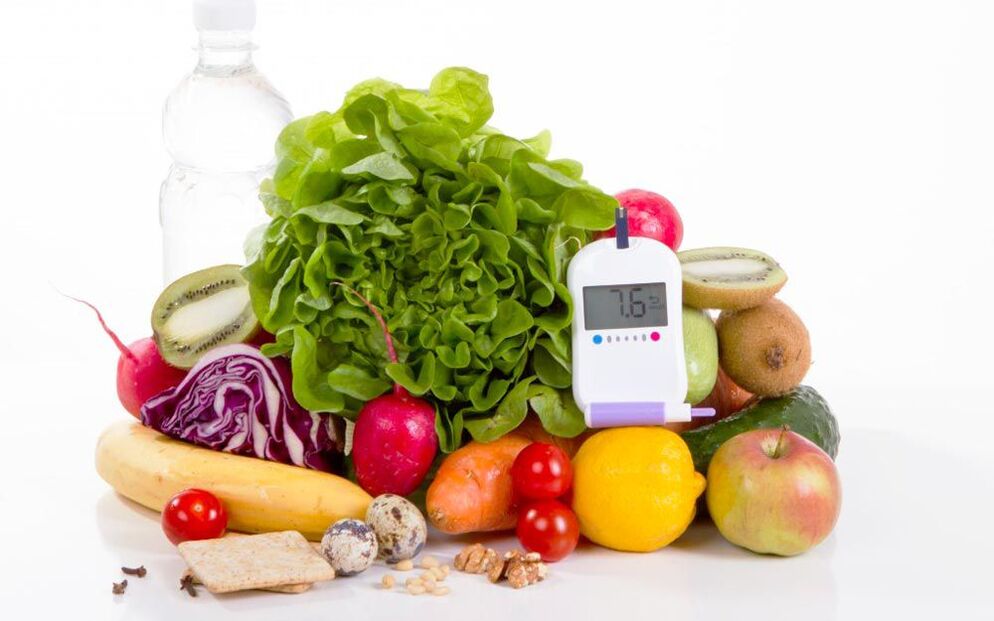
Diabetes mellitus is a widespread disease that every adult may have heard of. It can be congenital or acquired during life, but in any case it is chronic and cannot be completely cured. Many have heard that diabetes is not a disease but a way of life. After all, the patient has to adhere to a special diet for life and use individually selected drugs and not always insulin injections. In general, the diet in diabetes mellitus cannot be considered a diet in the broadest sense of the word, as there are not so many restrictions and most of the forbidden products with similar taste properties can be substituted, but are harmless to the sensitive body of a diabetic.

What is diabetes mellitus and its types?
Diabetes mellitus is a chronic disease in which the glucose metabolism is disturbed. It can be a result of a decrease in the amount of insulin hormones produced by the cells of the pancreas, then type 1 diabetes mellitus (insulin dependent) is diagnosed, or it can be the result of regular overeating, which leads to obesity, excessive stress and other factors, then diabetes mellitus developsType 2 (not insulin dependent).
Insulin is a biologically active substance that is released into the blood, traps a glucose molecule, and transports it to the desired cells.
It is type 2 diabetes that is most commonly diagnosed today and requires closer attention from doctors as well as adherence to special dietary principles as it is a result of the unhealthy lifestyle that a person leads. With a regular intake of large amounts of carbohydrates in the body, the pancreas works occasionally and ultimately either becomes unable to function properly or produces "damaged" insulin that cells and tissues cannot perceive. This means that such insulin is unable to functionis to take up glucose and transport it to its destination because the cells "do not see" it, i. develops insensitivity to it. Last but not least, the changes in the hormonal background that inevitably occur with age play a role.
In both cases, there is a sharp increase in glucose (sugar) in the blood and the development of characteristic symptoms:
- Increased thirst;
- dry mouth;
- weakness;
- Deterioration in eyesight;
- increased appetite, etc.
Type 2 diabetes mellitus is most commonly diagnosed, in 85-90% of patients. It usually occurs after 40 years, and is particularly common after 65 years. Such susceptibility of the elderly to the development of disorders of carbohydrate metabolism is a consequence of a decrease in physical activity and a decrease in muscle mass, which is the main consumer of glucose, and the increasingly observed abdominal obesity becomes an additional factor that increases the risk ofdevelop non-insulin dependent diabetes.
Abdominal obesity is the predominant deposition of fatty tissue in the abdomen.
Diagnosing diabetes is not difficult. To do this, a blood sugar test is carried out. Obtaining increased indicators serves as a reason for further examination and selection of the optimal tactics of treatment, which mandatory components include nutritional correction.
Why it is important to follow basic nutritional principles
In any type of diabetes mellitus, the blood sugar level rises, but the cells cannot absorb it due to a lack of insulin or the development of insulin resistance. Because glucose is a monosaccharide that is produced when carbohydrates are broken down, it acts as the body's main source of energy. Therefore, if the tissues do not absorb it in sufficient quantity, they feel hungry, which, through the transmission of the appropriate nerve impulses to the brain, leads to the appearance of a similar feeling in humans. As a result, patients with diabetes may feel like eating something particularly sweet an hour after a hearty meal.
As a result, patients openly eat high-calorie foods containing carbohydrates, which in type 2 diabetes mellitus quickly leads to weight gain and the progression of obesity. This leads to an even greater increase in blood sugar levels, an increase in the load on the pancreas, an increase in the production of insulin, an increase in tissue resistance, a deterioration in the condition, that is, the formation of a malignant vicious circle.

If you do not intervene in time in such situations and interrupt this cycle, high sugar levels (hyperglycemia) lead to the development of ketoacidosis and diabetic coma. Initially, the patient is very thirsty and often goes to the toilet, then weakness, shortness of breath quickly appears, a characteristic odor of acetone from the mouth and urine appears, nausea and vomiting appear. Without competent medical care, confusion and ultimately diabetic coma develop.
In addition, long-term uncontrolled diabetes mellitus (decompensated) can lead to the development of:
- Retinal lesions with subsequent irreversible blindness;
- impaired kidney function and chronic kidney failure;
- poorly healing trophic ulcers on the legs, very difficult to treat;
- Osteoporosis, which is fraught with the possibility of breaking any of the bones of the skeleton, including the spine, even with minor impact;
- Diseases of the heart and blood vessels, organs of the digestive tract, etc.
Therefore, it is important not only to diagnose diabetes mellitus in a timely manner and take the drugs prescribed by the endocrinologist, but also to strictly follow the recommendations on diet.
Diet functions
Diets in type 1 and type 2 diabetes mellitus have some differences that patients should understand. Regarding the diet for insulin-dependent diabetes, in which patients receive lifelong replacement therapy in the form of regular insulin injections, doctors in different countries see the need to limit simple carbohydrates in different ways.
Foreign endocrinologists believe that there is no need to reduce the amount of their consumption in type 1 diabetes with properly selected insulin therapy. General practitioners believe this is fraught with undesirable consequences and insist on limiting, but not completely giving up, consumption of simple carbohydrates, as with non-insulin dependent diabetes. Such arguments are inappropriate in type 2 diabetes mellitus, as the consumption of sugar can have dire consequences, which is not questioned in any country.
In addition, people with type 1 diabetes should be able to count bread units (XE), and people with type 2 diabetes should be able to determine the glycemic index (GI). The diet should be designed so that these indicators of daily nutrition correspond to the developed norms.
Therefore, today, patients with diabetes mellitus are prescribed the so-called diet No. 9 in various modifications, the differences between which are insignificant. Which table is most suitable for a particular patient is determined by the endocrinologist based on the results of the analysis and the condition of the person.
In general, Diet No. 9 is designed to normalize carbohydrate metabolism by reducing the amount of simple carbohydrates consumed and, accordingly, the level of glucose in the blood. Thanks to this, it is possible to normalize blood sugar levels, prevent the development of possible disorders of lipid metabolism and complications of the disease.
Diet No. 9 assumes a complete rejection of simple carbohydrates against the background of consuming no more than 300 g of complex carbohydrates daily, while maintaining the amount of protein foods within the physiological norm.
Basic nutritional principles
The following recommendations should be observed in the case of diabetes mellitus of any kind:
- Food should definitely be fractionated and consist of at least 5 meals, especially in the case of an insulin-dependent form;
- Breakfast is a compulsory meal;
- when compiling the menu, the physiological ratio of proteins (meat, fish dishes, dairy products), carbohydrates (cereals, bread) and vegetables should be observed, they should be 25%, 25% and 50% respectively;
- Foods with a low glycemic index and a high proportion of vegetable fiber always have a nutritional benefit;
- every meal starts with vegetables and ends up with protein;
- the amount of salt should not exceed 5 g per day;
- fasting in diabetes is prohibited if necessary, in order to reduce weight, this is done by increasing physical activity;
- When choosing a method of cooking vegetables, it is recommended to give preference to minimal heat treatment or to abandon it completely. Cooking, baking and steaming are ideal.
- A vegetarian diet for diabetes is not the best choice, although it will improve disease progression and increase insulin sensitivity, you can only switch to it with the permission of an endocrinologist.

Diet for Type 1 Diabetes
Insulin-dependent diabetes is usually diagnosed in childhood. Since the cause of its development is the destruction of the cells of the pancreas that synthesize insulin, it is necessary to prescribe insulin therapy to patients, and the drug and dosage are selected individually. Insulin injections completely cover the deficit in the production of the hormone in the body, so there is no need for significant dietary restrictions, but the child's parents and then themselves must learn to correctly calculate the amount of carbohydrates consumed so that they of the administered dose of insulin. For this purpose, tables have been created that indicate the number of so-called grain units in each product.
In type 1 diabetes mellitus, the only thing to be rejected is:
- all drinks containing sugar, including juices;
- prepared breakfast cereals;
- Confectionery.
You must not eat more than 7 XE per meal and up to 25 XE per day. The amount of all carbohydrates consumed per serving volume is added up. For example, there is 2 XE in 3 tbsp. l. ready-made pasta, 4 tbsp. l. Rice, 14 tbsp. l. Legumes or 420 g tomatoes.
1 XE corresponds to 12 g of carbohydrates or 20 g of bread.
Sweets are not strictly forbidden, but only those who check the blood sugar level several times a day can afford them, they count XE accurately and can independently regulate the administered insulin dose.
In severe type 1 diabetes mellitus, patients are prescribed diet No. 9b and high doses of insulin. It involves the use of 400-450g of carbohydrates and is very similar to the diet of most modern people. It is allowed to consume 20-30 g of sugar a day.
In any case, the endocrinologist who is monitoring the patient's condition will tell you how to distribute the amount of food between each dose, depending on the type of medication he has prescribed. So when introducing insulin twice a day (morning and afternoon) it is necessary to compose the menu so that almost 2/3 of the total daily carbohydrate intake is accounted for by this time. In addition, you need to eat 2 times after each injection - 15 minutes after the injection and 3 hours after. Fractional nutrition and controlling the amount of XE is the foundation of the diet in type 1 diabetes.
If the patient suddenly feels weak after the injection, this indicates a lack of glucose in the body. In such situations, you should eat a piece of dark chocolate right away.
With an insulin-dependent form of the disease, the main difficulty lies in the need to control not the type of food but its volume and to count the bread units.
Diet for Type 2 Diabetes
In most cases, obesity is the main cause of the disease. Therefore, in type 2 diabetes, diet is the first and foremost part of treating and preventing complications. With its help, it will be possible to normalize sugar levels and control weight, which will prevent the occurrence of undesirable changes and worsening of the condition.
All patients must independently monitor their blood sugar levels daily with household glucometers and seek medical advice immediately if the values remain stable.
If the patient is diagnosed with an insulin-independent form of the disease of mild or moderate severity and his weight is within the normal range, he is assigned basic diet No. 9 with a daily caloric intake of up to 2500 kcal. In such situations, you cannot consume more than 275-300 g of complex carbohydrates from various sources per day.
With obesity, it is necessary not only to keep the level of glucose in the normal range, but also to reduce weight, since its excess affects the effectiveness of treatment and the well-being of patients. Therefore, in such cases, patients are prescribed the so-called reduced diet No. 9, which is characterized by a reduced calorie content due to an even greater restriction in the allowable amount of complex carbohydrates consumed daily. In this case, the endocrinologist will calculate this rate individually according to the degree of obesity. Therefore, in various cases, patients may be allowed to consume 100 to 225 g of carbohydrates and the total caloric intake should not exceed 1700 kcal per day.
What is not allowed
In type 2 diabetes mellitus it is therefore necessary to completely exclude from the diet foods with the so-called fast carbohydrates, ie those that are broken down into glucose within 15 minutes and absorbed into the bloodstream. They give a quick boost of energy, but do not create a feeling of fullness, so hunger returns very quickly after consumption. These include:
- Sugar;
- Honey;
- Confectionery, classic pastries;
- Ice cream, chocolate;
- Jams, jams, jams, preserves;
- sweet vegetables, fruits, berries (grapes, bananas, dates, pineapples, persimmons, dried fruits);
- White bread, loaf;
- Semolina;
- smoked meat, fatty foods;
- Mayonnaise;
- Fast food, snacks.
Special recipes including approved baking products have been created for diabetics.
Diet number 9 does not require complete rejection, but recommends minimizing the amount ingested as much as possible:
- Potatoes;
- Beets;
- Corn;
- Carrots;
- Soy products;
- Pasta;
- of bread.
If you are overweight, you need to completely give up all high-fat foods:
- Butter and vegetable oil, spreads;
- Sour cream, fat cheese, cottage cheese, cream;
- Lard, fatty meat and fish, skin-on chicken;
- Nuts, seeds;
- Alcohol etc.
In such situations, it is recommended to replace these products with vegetables that have a positive effect on carbohydrate metabolism. These are leafy vegetables, eggplant, cucumber, beet, cauliflower, pumpkin, zucchini, radish, etc.
It is imperative to try to avoid high-fat foods, especially canned foods, products from the meat processing industry and sauces, completely. They are replaced by boiled or braised diet meat (chicken, rabbit, turkey, low-fat yogurt without additives).
What can
Carbohydrates are an indispensable part of the daily diet and must be on the menu for diabetes, but only in acceptable amounts. Patients should only consume foods that are slowly absorbed in carbohydrates and are high in fiber. The:
- Vegetables;
- Whole wheat bread with bran;
- Whole grain cereals (8-10 tablespoons), with the exception of refined rice.
Since sugar in any form is forbidden for diabetics, its glucose-free substitutes have been specially developed. Many of them are many times sweeter than sugar and can be used in minimal amounts. Modern sweeteners include xylitol, stevia, sorbitol, fructose. However, studies have shown that some of them can negatively affect the body. Stevia is now considered the safest sugar substitute. It is obtained from natural raw materials and its sweetness exceeds sugar by 10 to 30 times (depending on the form of release: a powder made from an herb or an extract called stevioside).

It is important for patients to know the glycemic index of food. Today there are special tables that will help you choose and correctly calculate the allowable consumption. For diabetes, foods with a GI below 55 (apples, cucumbers, cherries, broccoli, lettuce, milk, cauliflower, etc. ) should be preferred. They are slowly broken down and cause little or no increase in blood sugar levels. Such products can be consumed up to 200 g during a meal, but preferably together with protein food.
Heat treatment increases the GI.
It may be used:
- potatoes (no more than 200 g per day);
- Meals based on meat and vegetable broth;
- lean meat and fish (chicken, turkey, saithe, pike, hake);
- Lenses;
- low-fat fermented milk and milk products, cheese with a fat content of less than 30%;
- Eggs (3-4 per week, but not more than 1 per day);
- Vegetable oil (no more than 1 tbsp. L. Per day);
- special sweets, waffles, breads for diabetics.
When making homemade compotes, sweeteners are added to them instead of sugar.
Diet for gestational diabetes
Pregnant women with a genetic predisposition for the development of diabetes mellitus can expect to develop what is known as gestational diabetes in the 20th to 24th week. It arises against the background of a hereditary reduced sensitivity of tissue to inulin, which is intensified by the hormones produced in increased quantities during pregnancy: estrogen, prolactin, cortisol. They are able to block insulin and make blood sugar levels rise.
Often after childbirth, carbohydrate metabolism gradually normalizes, as the hormonal background normalizes. However, if the basic principles of nutrition and diet are not followed, there is a risk not only of maintaining diabetes mellitus, but also the development of complications leading to premature birth, maternal pyelonephritis, fundus pathologies, as well as complications during childbirth. For the timely detection of gestational diabetes during pregnancy, blood sugar tests are carried out regularly and a diet is prescribed if hyperglycaemia is detected.
In such situations, women are recommended to:
- completely exclude simple carbohydrates from the diet (the same sugar, confectionery, chocolate, pastries, white and black bread, bananas, grapes, juices, dried fruits, etc. );
- limit intake of complex carbohydrates to the amounts recommended by the doctor;
- take away most of the daily diet for vegetables and unsweetened fruits;
- refuse to eat fatty foods, fried foods, semi-finished products, a variety of sausages and smoked products;
- When choosing a method of cooking products, give preference to baking, stewing, steaming.
- eat fractionated, preferably every 2 hours, highlighting 3 main meals (breakfast, lunch and dinner) and 2 additional ones (second breakfast, afternoon snack);
- drink at least 1. 5 liters of water.
Pregnant women with gestational diabetes are advised to measure their blood sugar after each meal.

All of these recommendations are relevant for the postpartum period. In any case, during the first few months of a baby's life, a nursing woman is forced to adhere to a hypoallergenic diet and refuse fried, fatty foods. The same diet will help eradicate gestational diabetes and avoid its transition to a chronic disorder of carbohydrate metabolism within 2-3 months of birth. If after this time the blood sugar level does not return to normal, the woman needs to see an endocrinologist for examination and development of treatment tactics.
Sugar lowering products
There are a number of foods that can help lower blood sugar levels. They are known as hypoglycemic and are recommended for patients with diabetes mellitus. But since every person is a unique biological system and has individual characteristics, they can react to certain types of food in their own way and not just cause allergic reactions. Therefore, although sugar-lowering foods can be of invaluable help to patients with diabetes mellitus, especially type 2, it is worth consulting an endocrinologist before starting daily intake.
So sugar-lowering foods are:
- Cherries (GI 22) - contains anthocyanins, which helps lower blood sugar and pressure and clears what is known as bad cholesterol. The daily norm is 100 g.
- Grapefruit (GI 29) - Contains naringin, a powerful antioxidant that helps increase tissue sensitivity to insulin. It is recommended to consume 1 medium-sized grapefruit or freshly squeezed juice from it daily (not commercially suitable). However, grapefruit can affect the quality of absorption of various medications, so it is necessary to consult with your doctor before including it on the menu.
- Cinnamon is a source of polyphenols that help keep blood sugar levels under control. The daily price is 1/2 teaspoon. It can be added to cottage cheese and oatmeal and is very suitable for making casseroles with apples.
- Broccoli is a valuable source of fiber that is so beneficial for diabetes. The daily norm is 200 g.
- Blueberries are one of the healthiest foods for diabetics because they contain valuable glycosides, tannins, and anthocyanins that help maintain normal glucose levels and reduce the risk of diabetic retinal damage. The daily norm is 200 g.
- Oatmeal and millet gruel are high in fiber, which help maintain sugar levels.
- Jerusalem artichoke is a natural source of insulin, thanks to which its use contributes to the normalization of glucose levels, and the presence of fructose in the composition provides a pleasantly sweet taste, which allows it to be added raw or to salads.
- Garlic is one of the healthiest foods for anyone as it is high in antioxidants, natural antibacterials, and other substances. Its use makes the pancreas work more actively, which is very valuable for patients with type 1 diabetes.
- Fish - Fish diabetics eat at least twice a week and try to replace meat dishes with it if possible. It helps normalize sugar levels and preserve essential polyunsaturated fatty acids.

For example, the diet for diabetes mellitus can be varied and tasty. With a competent planning of the menu, this does not lead to rejection, but, on the contrary, helps increase energy and efficiency, since it largely corresponds to the principles of rational nutrition. Remember, however, that with diabetes, maintaining normal levels of physical activity is important because exercise increases the sensitivity of tissues to insulin.



































